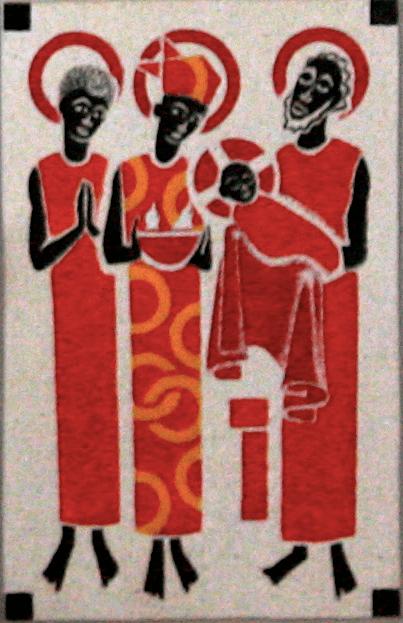A Sermon Preached on the Presentation of Christ in the Temple
(also known as Candlemas) (transferred from February 2)
at The Anglican Church of St. Thomas the Apostle, Kefalas, Crete
on Sunday, 28 January 2024.
The readings were Malachi 3:1-4, Psalm 24, Hebrews 2:14-18, and Luke 2:22-40.
This morning I want to think about the psalm, Psalm 24, so you may want to pull out your psalter and have a look.

Some General Comments about the Psalms
- They were sung, usually accompanied. We have no good idea what the tunes were, or how they were composed, or in what circumstances they were sung.
- We do know that there were choirs and instrumentalists in the Temple in Jerusalem. It appears that perhaps they used double choirs, calling and responding, or perhaps with a soloist and a choir.
- We read in 2 Samuel 6:16: David and all the house of Israel were dancing before the Lord with all their might, with songs and lyres and harps and tambourines and castanets and cymbals. There are also references elsewhere to ram’s horns and trumpets.
- The style of singing the psalms was probably more ecstatic and less meditative – not so much Gregorian Chant and Anglican Chant, and so perhaps not King’s College Chapel style, but more like popular music.
- The psalms come from an oral culture – and so the psalms may have been composed freely, on the spot, and shaped by repeated performance, and only later written down. Imagine Lennon and McCartney composing a song nose to nose, or a song being created in a sound check.
- The original language is Hebrew, and it is identifiable as Hebrew from the way it constructs verbs (technically, the waw/vav-consecutive formation used in narrative prose is absent). Because Hebrew is inflected by prefixes and suffixes, more can be said in fewer words than in English. Hebrew is typically a very concrete language, with fewer abstractions than Greek, Latin, French, or English.
- The verses have no set length, they do not rhyme, and the beats or emphases in the lines vary. The way in which they were sung somehow accommodated all this.
- The name of God, YHWH, is used, wherever you see LORD.
- After composition and use in the Temple, the psalms were later collected, and the book as we have it appears to be a collection of collections, perhaps edited 700 years after most of the individual psalms were written. Some of the later psalms – Psalm 119 and 146 – are probably later and are the product of a culture where writing was more common.
- In the Second Temple era the Jews read the psalms as a poetic form of the Torah, or instruction. Hence, there are five divisions within the Book of Psalms, just like the five books of the Torah.
- Christians, following on the use of the psalms in the New Testament, read the book as a witness or a testimony to Jesus, and it is in this context that we use it today.
A Reading of Psalm 24

- The first section of two verses affirms the ownership and sovereignty of Yahweh over the earth and all that is in it.
- The next section of four verses asks a question and then answers it.
- Who can ascend the hill of YHWH? The hill of YHWH is Zion in Jerusalem, and the holy place is the Temple.
- And the answer is that it is the pure, those who do not worship idols, or swear falsely. It refers to the company of those who seek God – perhaps the very people singing and listening to this psalm, who are the children of Jacob.
- There is a sense of movement here – beginning with the whole world, then ascending into the mountain, and entering into the holy place, just like that passage I quoted from 2 Samuel 6.
- The last section is well known as a chorus from Part II of Handel’s Messiah. The libretto was supplied to George Handel by Charles Jennens, who extensively used the psalms.
- The gates and doors of Jerusalem and of the Temple are personified – they have heads to be lifted up.
- The question and answer comes back, repeated. Probably soloist and choir.
- YHWH is identified as a warrior king, strong and mighty in battle, YHWH of hosts.
- Scholars speculate that this is a psalm used when the Ark of the Covenant was taken out to battle.
What might Psalm 24 have to do with the Presentation of Christ in the Temple?
- Mary and Joseph can be seen as being pure of heart and clean of hands.
- Simeon and Anna are also clean and pure, and offer the blessing on behalf of YHWH.
- Jesus, then, is the King of Glory. Jesus is the warrior, fighting not against Canaanites or Syrians, but against, as the Letter to the Hebrews puts it, the one who has the power of death, that is, the devil, and free those who all their lives were held in slavery by the fear of death.
- In Malachi, Jesus is seen as the one who has suddenly come to his Temple, and the day of his coming is challenging, but will purify and refine. He will come again, as an adult, to offer himself as a sacrifice in his death and resurrection.
So let us present ourselves to God, ourselves, our souls and bodies, as a whole and acceptable offering in Jesus. May we be purified and refined, so that we might be Christ in the world. May we challenge all that is evil and free those who are enslaved. May we lift up our heads and see the King of Glory!

